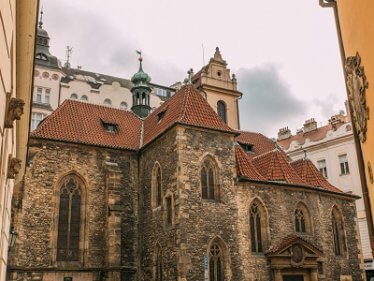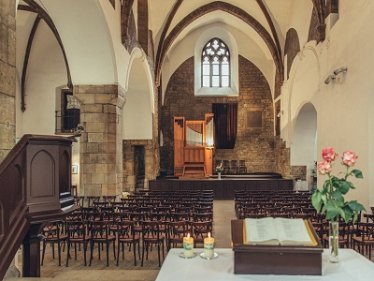Classical concerts in the church of St. Martin in the Wall - Schedule, Program & Tickets
Classical concerts in the church of St. Martin in the Wall
The Church of St. Martin in the Wall is located near Narodní trida and has been almost completely preserved as a medieval building - a rare example of valuable Romanesque and Gothic architecture.
It was built in the twelfth century in the village of Ujezd, which became known as the Ujezd of St. Martin. The church received its current name in the 13th century when King Wenceslaus I enlarged the castle and then surrounded it with a castle wall. The Wall divided Újezd into two parts, the inner part became part of Prague's Old Town. Most of Újezd remained behind the walls and was destroyed by the construction of the New Town under Charles IV. The south wall of the church became part of the city wall - hence the name Church of St. Martin in the Wall. As was customary, the church was surrounded by a school and a cemetery associated with one of the Prague legends.
In 1386 the mayor of the old town, Jiri Sverhamr, is said to have lived here. One day he came home from the town hall, put the seal of the town on the table with his belt and went into another chamber. His wife was bathing their baby and when the little one cried she gave him the seals to play with. She later forgot it and dumped it in the street with the water, where a townsman found it and took it back to City Hall. The city councilors immediately called the mayor and asked for the seal. He said he left it at home and promised to return it immediately. The councilors went after him and took an executioner with them, because losing the seal of the city was punishable by death at the time. When the mayor came up empty-handed, they beheaded him right in front of his house. The deceased was buried in the St. Martin cemetery.
A cross was erected in his memory at the place of execution and the house is still called the House of the Black Cross (Dům U Černého křížku). On the facade of house number 1 you will find a small black cross.
According to legend, the ghost of the dead mayor, with his head in his hands, keeps appearing around the church at night, warning untidy people not to end up like him.
Under Charles IV the church was rebuilt, the new nave was raised and vaulted, the tower and the presbytery were added. The rib vault from this period is one of the oldest surviving in the country.
Another interesting feature is the wood-beamed ceiling with a plant pattern, built after the 1678 fire. You will hardly find a similar ceiling in any other Prague church.
Although St. Martin in the Wall was one of the few churches that survived the Hussite Wars in the 15th century, it was closed in 1784 after a personal visit by Emperor Joseph II, despite many protests from Prague citizens. The church became a two-story house with commercial and storage space on the ground floor and residential units on the upper floor.
In 1904 the city of Prague bought the church building and it was successfully restored in the following years according to the design of Kamil Hilbert, whose initials “HK” are carved above the entrance gate with the number 1905 marking the date of the reconstruction. Since 1918 the church has been used by the Evangelical Church of Czech Brethren.
Concerts are held in the Church of St. Martin in the Wall throughout the year, and the church is heated during the winter months.
It was built in the twelfth century in the village of Ujezd, which became known as the Ujezd of St. Martin. The church received its current name in the 13th century when King Wenceslaus I enlarged the castle and then surrounded it with a castle wall. The Wall divided Újezd into two parts, the inner part became part of Prague's Old Town. Most of Újezd remained behind the walls and was destroyed by the construction of the New Town under Charles IV. The south wall of the church became part of the city wall - hence the name Church of St. Martin in the Wall. As was customary, the church was surrounded by a school and a cemetery associated with one of the Prague legends.
In 1386 the mayor of the old town, Jiri Sverhamr, is said to have lived here. One day he came home from the town hall, put the seal of the town on the table with his belt and went into another chamber. His wife was bathing their baby and when the little one cried she gave him the seals to play with. She later forgot it and dumped it in the street with the water, where a townsman found it and took it back to City Hall. The city councilors immediately called the mayor and asked for the seal. He said he left it at home and promised to return it immediately. The councilors went after him and took an executioner with them, because losing the seal of the city was punishable by death at the time. When the mayor came up empty-handed, they beheaded him right in front of his house. The deceased was buried in the St. Martin cemetery.
A cross was erected in his memory at the place of execution and the house is still called the House of the Black Cross (Dům U Černého křížku). On the facade of house number 1 you will find a small black cross.
According to legend, the ghost of the dead mayor, with his head in his hands, keeps appearing around the church at night, warning untidy people not to end up like him.
Under Charles IV the church was rebuilt, the new nave was raised and vaulted, the tower and the presbytery were added. The rib vault from this period is one of the oldest surviving in the country.
Another interesting feature is the wood-beamed ceiling with a plant pattern, built after the 1678 fire. You will hardly find a similar ceiling in any other Prague church.
Although St. Martin in the Wall was one of the few churches that survived the Hussite Wars in the 15th century, it was closed in 1784 after a personal visit by Emperor Joseph II, despite many protests from Prague citizens. The church became a two-story house with commercial and storage space on the ground floor and residential units on the upper floor.
In 1904 the city of Prague bought the church building and it was successfully restored in the following years according to the design of Kamil Hilbert, whose initials “HK” are carved above the entrance gate with the number 1905 marking the date of the reconstruction. Since 1918 the church has been used by the Evangelical Church of Czech Brethren.
Concerts are held in the Church of St. Martin in the Wall throughout the year, and the church is heated during the winter months.



